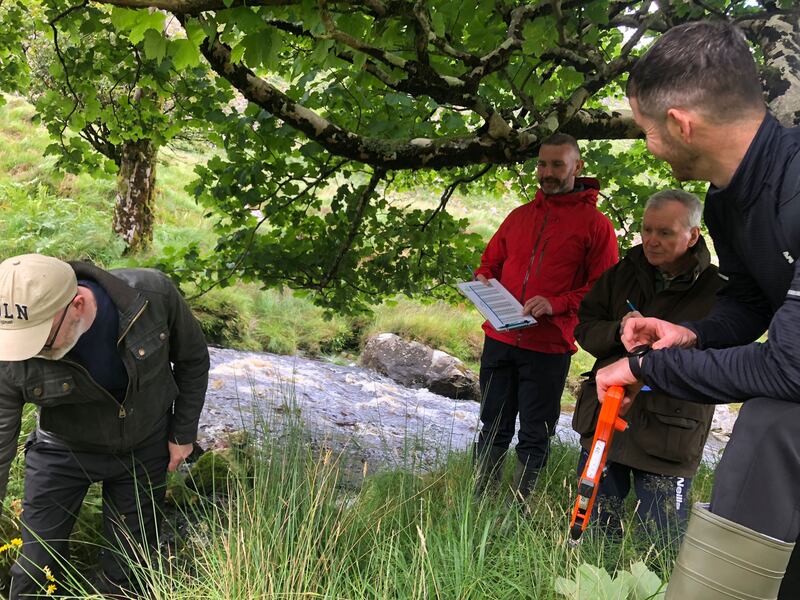It’s no secret that Irish rivers are in a poor state, with Environmental Protection Agency (EPA) figures pointing to only about 20 rivers in pristine condition in the early 2020s compared to 500 in the 1980s. The pressures on water quality and ecosystems are also well documented, with nitrogen and phosphorous run-off from agriculture, forestry and wastewater treatment plants the main culprits for polluting our inland waterways.
But what is perhaps less well known is the increasing number of passionate and engaged people involved in river conservation across Ireland. From the establishment of the first rivers trust, in 1994, to the 2020s, there has been an incredible growth of involvement in this environmental movement. There are now 15 rivers trusts in the Republic, three of which are cross border, and five in Northern Ireland.
As well as creating awareness of the importance of clean water for humans and wildlife, these local groups lead practical projects such as clearing invasive species on river banks, planting native trees, removing barriers for fish migration, developing natural flood management schemes and celebrating the historical cultural heritage of our lakes and rivers.
Take the Corrib Beo partnership in Galway, for example. It works with various groups to celebrate and cherish Lough Corrib, the River Corrib, its tributaries and canals.
“Our greatest achievement to date has been to increase the awareness of Lough Corrib as a resource. It’s the largest inland lake in the Republic and it was hidden in plain sight. Up to recently very few people, except for anglers, had access to it,” explains Micheál Ó Cinneide, chair of the Corrib Beo partnership of environmental groups.
Corrib Beo has organised talks and walks celebrating everything from the Viking longboats found in the lake and the area’s early Christian monastic traditions to the history of milling and brewing on the river and canals in Galway city.
“If people value the lake, they are more inclined to protect it,” says Ó Cinneide.
But the group is also working with farmers, residents, Irish Water, the Local Authority Waters Programme (LAWPRO) and other state agencies to address the declining water quality in Lough Corrib.
“There has been big investment from Irish Water but there are still algae blooms on the lake which is a sign of poor water quality,” says Ó Cinneide, who hopes the 2022-2027 river basin management plan will give community groups greater opportunities to work with state agencies to solve water pollution. Restoration of biodiversity and water quality requires complex application of science, engineering but also local knowledge.
“The state can’t restore water quality on its own. It needs to work with farmers and local communities to solve this.”
Ó Cinneide says that while LAWPRO works well with local communities, there is an urgent need for more funding for catchment groups including Rivers Trusts.
“We would like stronger support from LAWPRO as catchment groups including rivers trusts will not be able to sustain themselves and develop unless the scale and funding is like the funding for other non-governmental organisations in Ireland,” he adds.

The Inishowen Rivers Trust in Co Donegal stands out as one of the rivers trusts that has put education and training at the core of its activities.
“We needed to understand rivers more and how they function so that we could bring the community with us,” explains Dr Trish Murphy, project manager with the trust.
The group’s extensive experience in doing river guardian training programmes has resulted in it recommending courses to other rivers trusts around Ireland.
“The first course we’d recommend is about learning to read the landscape. You need to know the geography, where the river is coming from, what’s in it and how it works and travels,” says Murphy.
Because of its local expertise, the Inishowen Rivers Trust has also completed Ireland’s first community-led natural flood management scheme.
“We worked in the mid/upper catchment, putting in trunks on the banks to create leaky dams and stuffing gullies with forestry thinning, both of which slow down the flow of water to prevent flooding downstream,” says Murphy. The group also engaged with farmers with riparian land – land which borders rivers and streams – teaching them about water quality, planting trees, fencing off waterways and repairing river banks.

The East Wicklow Rivers Trust is one of the newer rivers trusts in Ireland. Formed in 2020, it has held training workshops to teach people how to assess the water quality of the Dargle, Vartry and Avoca rivers and their tributaries. It is also in the midst of employing a contractor to remediate a barrier preventing migratory fish from moving upstream of the Derrywater river.
“This will involve building a structure made from geologically appropriate rocks to build a slope downstream of a concrete plinth which secures the 300-year-old bridge at Ballinglen between Aughrim and Tinahely. Such a structure will raise the water level, giving greater depth for the fish to move upstream,” explains Luke Drea, project manager with the trust. This campaign has received funding from Inland Fisheries Ireland and expert support from Wicklow County Council.
The Nore River Catchment Trust is another of the newer rivers trusts in Ireland. It evolved following consultations in community halls to see what people most wanted to do about their local rivers. So far, activities have included planting native trees on two farms whose lands border the River Nore.
“It’s about getting people together so they can understand and appreciate each other. So, for the tree planting, we had local people and corporate volunteers working with the farmers,” explains Mags Morrissey, who has worked part-time for the trust for more than a year.
Throughout the month of June volunteers from local Scouts and Tidy Towns groups, GAA clubs and kayaking clubs came together to tackle Himalayan balsam, an invasive species which has been spreading for years along the banks of the Nore, pushing out native species.
“It was a really good project and very satisfying work. We removed millions of plants and when you consider that each plant has between 800 and 1,000 seeds, we’ll see the benefits of this work next year,” explains Morrissey. Farmers and the National Parks and Wildlife Service also joined volunteers to remove giant hogweed, another invasive species, from banks of the river in Co Laois.
Morrissey says her group has benefited from being a member of the recently formed iCatch Hub network of Rivers Trusts.
“Being part of it makes you feel like you’re not on your own doing this work. Also, there is great access to knowledge from other parts of the country about training, funding and things like templates for health and safety documents,” she adds.
The members of iCatch meet online each month for expert talks and training. The Rivers Trusts also produce a monthly newsletter and an iCatch website with training videos, photo galleries and how-to-guides will come on stream this autumn.
The Rivers Trusts also hold an all-Ireland conference each year in the spring and, in the autumn, they co-host the Communities Caring for Water conference with the Local Authorities Water Programme.
Want to get involved? Read more on joining or donating to The Rivers Trust here.
















